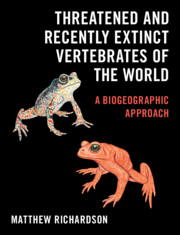Book contents
- Threatened and Recently Extinct Vertebrates of the World
- Threatened and Recently Extinct Vertebrates of the World
- Copyright page
- Dedication
- Contents
- Foreword
- Preface
- Acknowledgements
- Chapter 1 The Arctic Realm
- Chapter 2 The Palearctic Realm
- Chapter 3 The Afrotropical Realm
- Chapter 4 The Madagascan Realm
- Chapter 5 The Indo-Malaysian Realm
- Chapter 6 The Papua-Melanesian Realm
- Chapter 7 The Australian Realm
- Chapter 8 The Polynesian Realm
- Chapter 9 The Nearctic Realm
- Chapter 10 The Caribbean Realm
- Chapter 11 The Neotropical Realm
- Chapter 12 The Patagonian Realm
- Chapter 13 The Antarctic Realm
- Chapter 14 The Oceanic Realm
- Chapter 15 Global Balance
- Bibliography
- Index
Chapter 3 - The Afrotropical Realm
Published online by Cambridge University Press: 24 February 2023
- Threatened and Recently Extinct Vertebrates of the World
- Threatened and Recently Extinct Vertebrates of the World
- Copyright page
- Dedication
- Contents
- Foreword
- Preface
- Acknowledgements
- Chapter 1 The Arctic Realm
- Chapter 2 The Palearctic Realm
- Chapter 3 The Afrotropical Realm
- Chapter 4 The Madagascan Realm
- Chapter 5 The Indo-Malaysian Realm
- Chapter 6 The Papua-Melanesian Realm
- Chapter 7 The Australian Realm
- Chapter 8 The Polynesian Realm
- Chapter 9 The Nearctic Realm
- Chapter 10 The Caribbean Realm
- Chapter 11 The Neotropical Realm
- Chapter 12 The Patagonian Realm
- Chapter 13 The Antarctic Realm
- Chapter 14 The Oceanic Realm
- Chapter 15 Global Balance
- Bibliography
- Index
Summary
The Afrotropical Realm includes all of sub-Saharan Africa along with certain coastal islands such as the Cape Verde Archipelago. Madagascar, although traditionally included within Africa, is treated separately here. Biogeographically the Afrotropical Realm is divided between the African and Guineo-Congolian zoogeographic regions. Africa as a whole has a wide range of climates and habitats, ranging from subtropical to temperate. South of the Saharo-Arabian Region the vast North African desert turns into subdesert, grass, and shrub savannas, and finally to more or less dense wooded savannas. Still further south, forests appear; such growths reach their optimum development in the Congo Basin. In fact, Africa both north and south of the equator can show all types of nature from extreme desert to extreme rainforest. Savannas cover about 40 per cent of Africa, in both subtropical and tropical areas, and they vary greatly from region to region. Africa’s savannas, steppes, arid plains, and subdeserts stretch in an arc across the continent. Beginning in East Africa between the latitudes 20° and 10° N, they fill practically the whole of Africa south of 10° S with the exception of the Cape. Some of these plains have become or are becoming deserts; others are still fertile grass or tree savannas, which in places turn into open forests.
- Type
- Chapter
- Information
- Threatened and Recently Extinct Vertebrates of the WorldA Biogeographic Approach, pp. 92 - 169Publisher: Cambridge University PressPrint publication year: 2023

